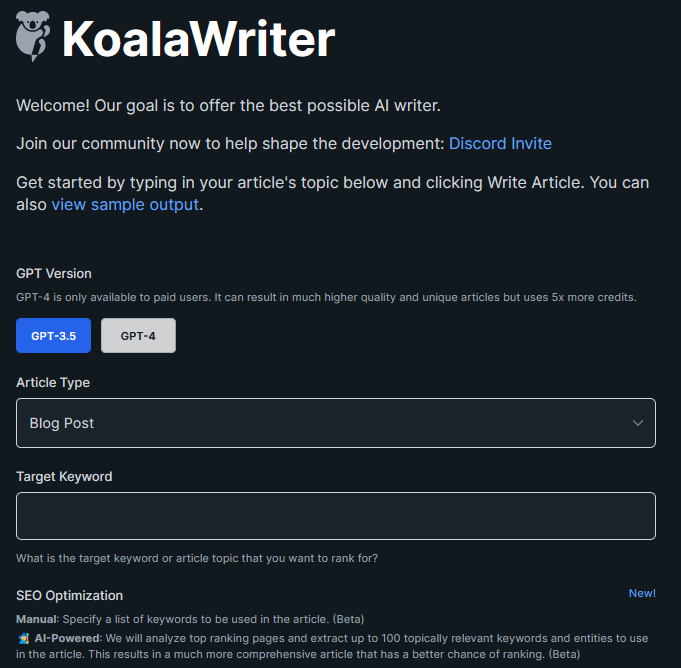
Want to publish more content on your blog, but struggle to focus?
Does the sheer amount of content you need to run a successful blog feel overwhelming?
It’s true:
Content creation doesn’t come easy for many of us, especially if we struggle to take action.
But I found a solution.
It’s called AI blogging. It works by using artificial intelligence to assist in content creation for your blog.
And in this post, I’m sharing my AI blogging strategy, so that you can produce more content in less time, AND with less overwhelm.
The best bit?
The content ranks in Google and converts traffic into buyers.
Keep reading.
Table of Contents
What is AI Blogging?

AI blogging is where you, the blog owner, uses AI to research, produce, and optimize content for your blog.
It’s the ultimate way to hack time management for bloggers.
Thanks to the increasing popularity of AI writing software, AI blogging has become a common practice for many bloggers.
AI bloggers can use these tools to generate catchy headlines, relevant outlines, and useful content.
However, for best results, AI writing tools need to be used wisely.
If no strategy is in place to ensure published content is helpful for the reader, the content simply won’t rank.
It could even result in a Google penalty in a future algorithm update.
Why I’m Using AI to Create Content
The main reason is my lack of time and attention.
I recently found out I have ADHD. After attempting to achieve success with blogging for 12 years, I finally understand why I’ve struggled.
My brain doesn’t function properly.
The specific issue I have found with blogging is my inability to maintain focus.
An ADHD brain also links to perfectionism and the overcompensation of getting things right.
In the past, when I tried to write content, I found it almost impossible to produce enough consistently.
If I add up every piece of content I’ve ever started, it would still only amount to a couple hundred posts. In 12 years!
In the blogging game, that’s a spit in the ocean.
Now, it’s my goal to become a full time blogger in less than one year.
So, I’m using AI tools to take the pain out of creating content from scratch.
AI assists the writing process and helps prevent writer’s block.
It’s also helping me lower my unrelenting standards and perfectionism in writing.
Before sharing my exact AI blogging strategy, let’s first look at some AI tools I’m using.
Best AI Blogging Tools for Content Marketers
Here are some of the tools I’m currently using and getting incredible results with.
Autoblogging
Autoblogging is a one-click AI writing tool. I started using this tool in 2022 and was blown away by how human-like the writing sounded.
Part of my marketing strategy consists of outlining every article before writing a word of content.
And this tool lets you input your outline and include keywords to get better results.
Most AI tools don’t create entire blog posts in one hit. You have to guide them by providing suggestions and context.
Whereas Autoblogging is different because it does most of the work for you.
You have two options: Quick Mode or Pro Mode.
With Quick mode, you simply use the title of your post, followed by some keywords in brackets.

And with Pro mode, you enter the article title along with your subheadings to get more refined results.
Whichever option you choose, after you click Generate Article, you’ll have a full post written within a few seconds.
ZimmWriter
ZimmWriter is a desktop application for Windows. It allows you to generate AI content anywhere you can edit text.
For example, if you want to write directly in your browser such as Google Docs or Google Sheets, or a desktop app like Obsidian.
You simply type a prompt, highlight it and click the magic command (ctrl + 1), then it generates a response.
Additionally, this tool has an SEO content writer with tons of customizations. You can add a custom outline, scrap, and summarizer text or URLs, and automatically insert related keywords.
Another great feature is that it connects directly to the GPT API, so the cost of an article costs pennies to a couple of dollars.
Article Forge
Article Forge is an AI content generator similar to Autoblogging, but it has a better user interface.
You can add custom headings or get the tool to come up with the outline for you.
Article Forge also uses different technology from other AI writing tools, providing more accurate results.
Currently, I find the content quality of Autoblogging to be slightly better than Article Forge. Sometimes Article Forge can produce better results, but it depends on different factors and the type of content you’re writing.
However, I’m excited to see where Article Forge is going as the content is constantly improving.
ChatGPT
You’ve most probably heard of ChatGPT by now. You may have even played around with it.
But did you know you can use it to create blog content?
Problem is. It needs a lot of guidance and human editing before posting on your blog.
Well, this AI blogging strategy will provide you with the exact steps to use it effectively.
AI Content Generation Best Practices
If you want to use AI generated content effectively, we need to set some ground rules.
Here’s how to use actual intelligence when using artificial intelligence.
1. Always improve AI content before publishing
This is a simple rule that I think many bloggers will neglect.
They will take advantage of AI writing tools foolishly, publishing thousands of AI-generated content without human editing.
Only to have their site wiped from Google’s index in the future.
But not you.
You’re smarter! You’ll use AI tools wisely, read each post and improve it so that it ACTUALLY helps the reader.
You will also edit the content for conversions so that it motivates people to become a subscriber or buy products you recommend.
Doing so helps you become a better writer, which helps you find more opportunities to find more content and to help your audience.
2. Spend 80% on content strategy
A wise man was once asked, “What would you do if you had just five minutes to chop down a tree?”
He answered, “I would spend the first three minutes sharpening my axe.”
The same goes when publishing content, especially when using artificial intelligence.
That means 80% of your time should be spent on content strategy and 20% on producing and editing the content.
Why?
Because it’s hard to determine which articles will rank for a new site. You can put all of your attention on quality content, and it still might not rank.
You could focus on building backlinks, but that takes you away from publishing content.
Additionally, if you use AI to help you publish more, you will save a lot of time on content production.
That means you can spend more time on what you can control; content strategy.
If each article helps solve a broader problem than each individual article, you can strategically connect them together to build more relevance for your blog.
More on this later in the post.
3. Only use AI with good intentions
Does it even need to be said?
That AI shouldn’t be used to trick people. If you have the intention to make a quick buck by misleading people, then you’re not welcome here.
It’s as simple as that.
Technology should be used responsibly and with good intentions.
I’m also not advocating using AI tools as a freelancer unless whoever you write for asks you to.
So, to be clear, use AI tools simply to assist you with your own sites. And use them with good intentions of helping your readers.
5 Step AI Blogging Strategy
1. Define the problem your content is solving
Each piece of content you publish needs to center around helping the reader solve one problem.
Why?
Because human beings are twice as motivated to move away from pain than move towards pleasure.
If your content only focuses on butterflies and rainbows, it won’t be half as effective.
Here are two examples of finding the pain point:
- Article title: 5 Posture Support Benefits
The solvable problem here is a simple one; back pain caused by bad posture.
- Article title: iPhone 27 Review
A not-so-obvious problem; save the need for an additional camera on vacation, but take professional quality photos.
The pain point here is subtle, yet still a powerful one. Reducing the worry and space needed to carry a professional camera on vacation.
Ideally, each post solves smaller problems that support solving a larger problem.
For example, in the first article idea above, the bigger problem is living a sedentary lifestyle and the solution is forming better habits.
An example of the second idea could be a blog focusing on minimalism when traveling.
2. Find your keywords
The success of this AI blogging strategy comes down to three things:
- Diligent keyword research
- Topical relevancy
- Strategic content marketing
As I’ve mentioned already, 80% of your time should be spent on research and planning. If you throw random keywords at an AI tool and hit publish, you’re shooting yourself in the foot.
So, when finding keywords, make them hyper-related to each other, but with a different search intent.
Why?
Because it creates more opportunities to internally link them together, which has powerful Search Engine Optimization (SEO) benefits.
Moreover, readers will stay on your blog for longer, which has even more benefits.
For example, ever heard of Mr. Money Mustache?
It’s a blog about personal finance and early retirement, AKA, FIRE (financial independence, retire early).
I found this blog about 10 years ago. After reading the first article, I had another 8-10 tabs open in my browser.
There was so much wisdom and so much to learn, I was hooked.
The blog made such an impact on me, I’m writing about it now, 10 years later!
That’s powerful.
So, when performing keyword research, keep topical relevance in mind.
Put yourself in the reader’s shoes and ask yourself; What else could this article link to that’s relevant?
Then, it’s time to plan your content strategy.
3. Use strategic content marketing
Content marketing guides people from unawareness of their problem, all the way to buying something that can help solve it.
So you need to think of the bigger picture when developing your AI blogging strategy.
A good place to start is to find keywords at each stage of the funnel.
People at the top are trying to figure out what the problem is. In the middle, they’re learning how to fix it, and at the bottom, they’re buying things.
This is reflected in the type of content they’re searching for:
- Top-of-the-funnel keywords include questions that start with ‘what’ and ‘why’.
- Middle-of-the-funnel keywords teach something with ‘how to’ content.
- And the bottom-of-funnel keywords cover things like case studies and reviews.
To go one step further, I even plan all of my internal links upfront.
I use a markdown editor called Obsidian to plan all my articles. This tool allows you to internally link between files and see a visual representation of all the connections.
4. Build a Topic Cluster for Topical Relevancy
In 2020, I stumbled into the world of personal knowledge management, which gave me the idea to do the same for the blogs I create.
Some people refer to personal knowledge management as creating a second brain. It’s a place where you can store everything you learn, which helps improve memory, learning ability, and critical thinking.
It also creates these knowledge graphs to help visualize how everything connects together.

And this is how I map out all the content for my blog in Obsidian.
I take all the keywords I found and add them as separate files in Obsidian. Then, I write subheadings for each post and add internal links to other posts that make sense.
Each internal link leads the reader down the funnel or provides them with more context.
I will do this in bulk, creating a topical cluster of 15 – 30 articles in one session. Then, I can focus on content generation for each post with an AI tool.
5. Create Each Article with Your AI Tool of Choice
Now for the fun part.
Using an AI tool, you can get assistance to write an SEO-optimized article super fast.
You can use any tool you like. My recommendation for complete beginners is to play around with ChatGPT.
Start writing prompts to create each aspect of the blog post.
These include:
- The blog post outline
- Crafting a catchy headline
- An article introduction
- And filling in the subheadings with content
Doing this manually to start will help you get familiar with the content creation process.
Once you’re comfortable, you can invest in a tool like Koala Writer or Autoblogging for a more automated approach.
You simply take one of your keywords, enter it into an AI content writer and click generate.
For example, here’s what it looks like using Koala Writer:

Once the AI tool has written the post, you can read through it, make edits, and add a human touch.
Furthermore, it’s important to make sure the article is well-optimized for SEO.
We will look at this in more detail in another post.
How to use AI to write articles.
Pros and Cons of Using AI Tools
Pros:
- Write more content faster: AI tools can generate content quickly, thereby saving valuable time for writers.
- It’s cost-effective: Instead of hiring multiple writers, you can use AI tools to generate large volumes of content, thus reducing costs.
- Helps with content ideas: AI tools can help you research content and come up with new content ideas you never would have thought of.
- Content optimization: Some AI tools optimize content for search engines by incorporating relevant keywords and ensuring proper keyword density.
- Consistency: AI tools help maintain consistency in content writing, especially when creating multiple pieces of content on a similar topic.
Cons:
- Can lower creativity: While AI tools can spark creativity, relying on them too much can have negative consequences.
- Difficulties understanding nuance: AI tools may miss cultural references or subtle linguistic nuances, resulting in content that might be technically correct but doesn’t resonate with readers.
- Requires supervision: AI-generated content typically requires a human editor to check it for mistakes or inaccuracies, adding an extra step to the process.
- Lacks emotional connection: AI tools often struggle to replicate the emotional connection or personal touch that human writers can add to their content.
- Ethical concerns: Some people are worried about the implications of AI-generated content and the potential for these tools to be used dishonestly.
Can AI Replace Content Writers?
That’s like asking, can AI replace starting a family?
Think about it this way.
As the world becomes even more digital and technologically advanced, the more skeptical people will become.
Sure, it’s possible that one day, AI will be able to create entire blogs perfectly.
But without a human behind it, what’s the point?
People want connection and guidance. They want to follow someone who has experience, not follow the instructions of artificial intelligence.
Therefore, I think writers will have to adapt by showing more of their human side.
This will help real bloggers who want to help their audience stand out from the rest.
Conclusion
AI technology is gradually taking over the internet, so developing an AI blogging startegy is a wise move.
Following the steps in this post will help you utilize AI in your content marketing efforts and niche websites.